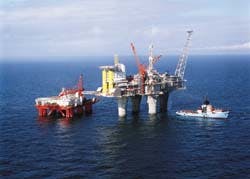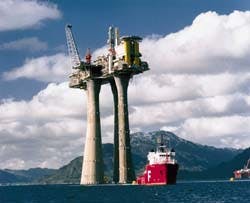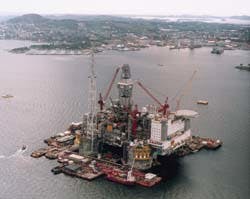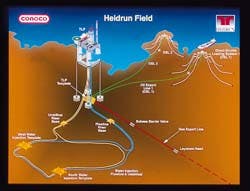Troll and Heidrun: end of an era or forerunners of a modern world?
Neil Potter
Contributing Editor
Troll A platform alongside the Polycastle accommodation flotel.
If only Norway could have arranged for the platforms for Conoco's Heidrun, Shell's Troll Gas and Norsk Hydro's Troll Oil all to have sailed away on the same day, what a majestic procession that would have been. Indeed, it would have been something unique in the industry's history.
For each of them is a milestone in development, not merely on the Norwegian CS, but worldwide.
- Heidrun (220,000 tonnes) is the world's first concrete TLP.
- Troll Gas, 1,005,000 tonnes and 472 metres high, is the tallest concrete structure ever moved on the face of the earth.
- Troll Oil (209,000 tonnes) is the world's first concrete semi-submersible production unit.
But things just don't happen that way. So it was that the pack was led this year by Troll Gas on May 10, followed by Heidrun on June 26 and Troll Oil on July 1.
Apart from the sheer elegance of these structures, the thought did occur that perhaps one was witnessing the last of the big ones. Who knows? But certainly Norwegian operators, perhaps a little behind the UK in the past in this respect, are now moving towards favoring floating production vessels.
Whether TLPs or concrete floaters or platforms will be suitable when development of areas such as the Voering Basin comes along remains to be seen. But one fact is for sure: the lifespan of Troll Gas is put at some 70 years, and Heidrun 50, which doesn't sound suitable for a production vessel!
History of concepts
Trolls have for centuries played a role in Norwegian folklore. The Troll Field seems to have been around for so long it has also taken its place in history. The field was discovered in 1979 and almost 100 varying concepts had been studied before government approval was given in December 1986.
Troll Oil was not approved until 1992 and Heidrun, discovered in 1985, went through a variety of vicissitudes before receiving final approval in 1991. But these long periods, in the end, proved invaluable for the projects as they allowed for the utilization of advancing technology and innovations.
For Troll there are three phases: Phase I is the development of the gas reserves in Troll East; Phase II is the development of oil reserves in Troll West; Phase III is some time in the future when the Troll West gas reserves are developed by Statoil.
In effect, Troll Gas itself is three projects in one: the `simple' offshore platform (as opposed to one massive structure before onshore processing was chosen); two multiphase pipelines to take wet gas ashore; and the onshore gas processing terminal at Kollsnes. Troll, with reserves of around 1,250 bcm of gas (two thirds in Troll East) will be the cornerstone of Norway's future gas deliveries to Europe.
The concrete gravity base is itself 369 metres high. Built by Norwegian Contractors at a price of NKr4,150 billion (including mechanical outfitting), the dry weight is 656,000 tonnes. Total volume of concrete used is 245,000 cu m, and includes 100,000 tonnes of reinforcement steel.
It supports the 22,500 tonnes of topsides, which cost NKr3.5 billion, including the accommodation module and flare boom (Westmarin) and drilling facilities (Hitec Dreco), with the deck being built by Aker Stord for NKr2 billion.
It was the most complete deck ever delivered by a Norwegian yard. A total of around 3.4 million hours was required by Aker Stord to build the deck. It took 18 hours for the deck to travel from Stord to Vats where it was mated with the concrete gravity base on January 25.
The tow-out of the Troll gas platform was itself a superb sight. Few will forget the stately progress as it moved through the fjords and out into the open sea on its 174-mile journey to the field location in block 31/6. There were ten of the world's largest tugs, eight spread out ahead towing with two vessels steering from behind. At an average speed of 1 knot the tow took around 174 hours.
About 500 metres from location, the tugs moved into a star formation to position the platform precisely. It was then ballasted down in 300 metres of water and the 19 skirt piles penetrated 36 metres into the seabed.
The supply of electricity from land was connected. In mid-June conductor driving began so that drilling could start in August. Gas is scheduled to flow next April in preparation for first deliveries, from 14 wells on October 1, 1996 when Statoil takes over as operator. In total 39 producers and one observation well will be drilled by Transocean by the end of 1997.
The drilling modules are claimed to be the most advanced ever built. Operators will be able to control all the operations from the driller's cabin and the control room looks like an advanced aircraft cockpit. When the programme is finished the modules can be dismantled and shipped to shore for storage and returned for well maintenance.
This summer and autumn some 25 vessels will be involved in offshore operations, with 12 working at the same time. In July, Castoro Sei began laying the 36-inch wet gas pipelines from the platform to the tunnel outlets at an estimated rate of 2.5 km a day. The program had to be re-scheduled in June after the laybarge lost a section of the 16-inch oil pipeline from Troll Oil to Mongstad.
Laying started with pipeline pull-in, using a 500 tonne winch, into seal tube casings (custom made by Barr Thomson Engineering of Scotland) at the bottom of one of the platform shafts, without using divers. Inside the dry riser shaft the pipelines were welded to the pre-installed risers.
Most gas processing will be carried out onshore at the new NKr 2.8 billion processing plant at Kollsnes, near Bergen. This was originally planned to process 84mcm/d of gas towards the year 2000. The rapid build-up of gas sales has led to the installation of a third processing train and a fourth and fifth compressor. Plant modifications are already under way to increase throughput capacity to 100mcm/d.
Some 3.5 miles of tunnels have been driven through the rocks to carry the pipelines. In May Rockwater's Regalia installed the four 160 meter long spool pieces (36-in. and 40-in. diameter) which were connected to the riser bundles at the mouth of the tunnels. Fabricated by HMV in Haugesund, they are the largest spool pieces in the world.
Normally the pipelines are laid first followed by the spoolpieces, but because of a very tight pipelay schedule the process was reversed this time.
The seabed near the shore is very irregular, so it was partly levelled with 300,000 sq m of rock. Dolphin Offshore Contractors developed a four km umbilical which an ROV could drag along behind it to inspect the tunnels in a water-filled state, thus saving time and money.
Gas production is expected to reach 30 bcm/yr after 2000, with a plateau of 45 bcm/yr reached in 2005 and remaining at that level at current projections until 2016-2018.Troll A platform being towed out of a Norwegian fjord.
Troll Oil layers
In 1984 the Troll project partners were asked by the government to evaluate the possibility of production from the two thin oil layers of Troll West, one being 10-12 metres thick and the other 20-26 metres.
Previously it had appeared almost impossible to find commercially attractive ways of producing it, with the possibility of breakthrough from the gas cap above and the active aquifer below. But advances in horizontal drilling proved the practicality and in December 1991 Hydro submitted the development plan for the 20-26m layers.
The Troll Oil concrete sub-structure was built by Kvaerner Concrete Construction under an EPCI contract at its Hanoytangen facility near Bergen. The deck, built by Kaverner Rosenberg, was mated with the base in February this year, followed by module installation in April.
Rockwater installed the sixteen, 1.4-km anchor lines mooring system with the Regalia in readiness for the offshore hook-up by HMV, starting in July. This summer sees intense activity in the field with the installation and tie-in of subsea lines. Much of the work is being carried out by Stolt Comex Seaway under a NKr535 million contract for a programme which extends into 1996 and 1997.
This is the largest subsea development so far on the Norwegian continental shelf. The subsea systems, in water depths of 335 metres, comprise 23 satellite wells (22 producers plus 1 gas injector); twenty six-inch and two eight-inch flexible infield flowlines; 23 infield integrated service umbilicals; five manifold centres - four of six slots and one of eight slots; 11 flexible test and gathering lines- nine of 10 inches and two of nine inches; five main integrated service umbilicals; two production riser bases and one export riser base.
An extra six-slot template will be installed this year and initial production, scheduled for October 1996, will be from a four-well cluster.
Last year it was decided to extend the development to the thinner layers in what is known as the Troll West Gas Province. Recoverable reserves were recently upgraded by Norsk Hydro from 390 MM bbl of oil to 1 billion bbl (with 8.5 bcm of associated gas), following what it called significant advances in drilling technology.
Hydro plans to submit a preliminary development plan to the partners next year. It will then seek approval from the authorities at the end of 1996: a floating production unit will probably be installed in the northern part of the field, with the extra reserves in production perhaps by early 1999.(Right)The HeidrunTLP outside Stavangar.
(Below)Heidrun Field layout.
Heidrun handover
Conoco has been responsible for the development phase of Heidrun which, at 112 km south of the Arctic Circle, is the northernmost offshore field development to date. It will hand over operatorship to Statoil at first oil in mid-August.
When asked if he approved of this at the platform christening ceremony, Conoco president and CEO Constantine Nicandros said quite bluntly, "No". He then added "It was a condition of the licence and we signed it. I am very happy it is Statoil that is to take it over."
Recoverable reserves are put at 750 MM bbl of oil and 46 bcm of gas, 36 bcm of which lies in a gas cap. Oil production is expected to peak at 200,000b/d late next year, but Statoil is confident that it can increase this to 250,000 b/d. Oil will be produced for 21 years.
Associated gas will initially be reinjected until the 16-inch, 150-mile pipeline is laid to the Statoil/Conoco methanol plant at Tjeldbergodden next year, with gas export sales starting in April 1997. A large gas sales contract will be required before the gas cap can be tapped.
Originally Conoco looked for a steel TLP but Norwegian Contractors proposed concrete on the basis of cost and building time. Specially developed, lightweight aggregate concrete was used, reducing the weight at sea relative to conventional concrete by 40%, thus increasing buoyancy and allowing a greater deck load. The same lightweight concrete was used for the tow innovative 147 meter long module support of the beams.
The foundations were fabricated by Kvaerner Concrete Construction and floated out to the field and installed on the seabed through controlled balancing of water and air inside the foundations, eliminating the need for costly heavy-lift crane barges.
The 16,270 meter long steel tethers were towed to the field location and, contrary to the usual practice, attached to the foundations prior to platform arrival. The tethers are designed to allow the platform to move a maximum of 31 metres.
Use of glass-reinforced plastic for the 11 utility tanks and piping reduced platform weight by 300 tonnes. It also cuts maintenance costs.
For the first time titanium is used for the drilling risers. Conoco says titanium has a superior ability to resist fatigue from dynamic motion, is lighter than steel, more durable and does not corrode.
Sixteen wells have been pre-drilled by the semi-submersible Transocean 8- eight producers and two gas injectors on the template plus six subsea water injectors. So superbly was the programme run that, instead of two rigs only the one was required, and an extra well was drilled. Everything was completed five months ahead of schedule and NKr200 million saved.
Statistics are revealing 917 days total time, with 20.9 days downtime for weather and 29.6 days for rig repair; total cost NKr1.67 million; 148 casings set; 71,341 metres drilled; 1,667 metres cored; 674 ROV dives. Some NKr700 million will be saved over field life by using the direct shuttle loading system, thus eliminating storage requirement.
The design capacities of the production unit are: peak oil 30,000 cu m/d: peak water 40,000 cu m/d; peak liquid 65,000 cu m/d and peak associated gas 7 mcm/d. The platform has capacity for the future installation of a regional module of up to 5,000 tonnes for processing hydrocarbons from other Haltenbanken fields.
Statoil has plans to tap the complex lower Tilje and Aare reservoirs. A major drilling programme is planned by Conoco and Statoil to look for satellites either next year or 1997.
Copyright 1995 Offshore. All Rights Reserved.




